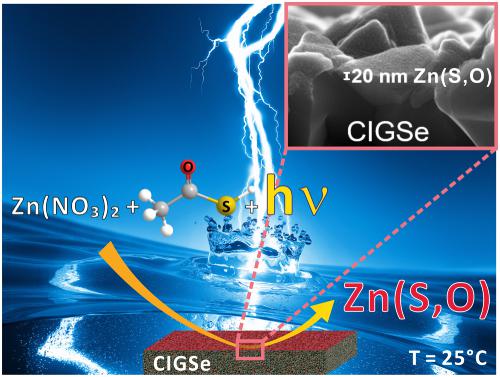当前位置:
X-MOL 学术
›
Prog. Photovoltaics
›
论文详情
Our official English website, www.x-mol.net, welcomes your
feedback! (Note: you will need to create a separate account there.)
Ammonia‐free, room temperature, and reusable photochemical bath for the deposition of Zn(S,O) buffer layers in Cu(In,Ga)Se2 thin‐film solar cells
Progress in Photovoltaics ( IF 8.0 ) Pub Date : 2018-01-19 , DOI: 10.1002/pip.2987 Serena Gallanti 1, 2 , Elisabeth Chassaing 1, 2 , Nicolas Loones 1, 2 , Muriel Bouttemy 2, 3 , Arnaud Etcheberry 2, 3 , Daniel Lincot 1, 2 , Negar Naghavi 1, 2
Progress in Photovoltaics ( IF 8.0 ) Pub Date : 2018-01-19 , DOI: 10.1002/pip.2987 Serena Gallanti 1, 2 , Elisabeth Chassaing 1, 2 , Nicolas Loones 1, 2 , Muriel Bouttemy 2, 3 , Arnaud Etcheberry 2, 3 , Daniel Lincot 1, 2 , Negar Naghavi 1, 2
Affiliation

|
Today, chemical bath deposited (CBD) Zn(S,O) is used at the industrial level in Cu(In,Ga)Se2 solar cells technology. The state‐of‐the‐art recipes of sulfur‐based buffer layers use thiourea as sulfide ions precursor and ammonia as complexing agent. However, such formulations require high concentrations of reactants, deposition temperatures between 60°C and 80°C with the problem of ammonia losses by evaporation and large water consumption. In this work, a novel bath chemistry for Zn(S,O) buffer layer deposition is developed where the thiourea is replaced by thioacetic acid as a sulfur precursor. The use of this compound allows the photochemical growth of a dense and homogenous Zn(S,O) layer on CIGSe absorbers. The main advantages of this solution compared to classical CBD‐Zn(S,O) bath are the deposition occurs at room temperature, the concentration of chemical precursors is 6 times lower, no use of a complexing agent such as ammonia, the reuse of the same bath at least for 4 consecutive times. The effect of the deposition time, the incident light power during deposition, and the successive use of the solutions on the thickness and composition of the film is discussed by means of scanning electron microscopy, and X‐ray photoelectron spectroscopy analyses. The photovoltaic performance shows conversion efficiencies similar to the classical thiourea/ammonia based process.
中文翻译:

无氨,室温和可重复使用的光化学浴,用于在Cu(In,Ga)Se2薄膜太阳能电池中沉积Zn(S,O)缓冲层
今天,化学浴沉积(CBD)Zn(S,O)在工业级别用于Cu(In,Ga)Se 2太阳能电池技术。硫基缓冲层的最新配方使用硫脲作为硫化物离子的前体,并使用氨作为络合剂。然而,这样的制剂需要高浓度的反应物,沉积温度在60℃至80℃之间,并且具有蒸发引起的氨损失和大量水消耗的问题。在这项工作中,开发了一种用于Zn(S,O)缓冲层沉积的新型浴化学方法,其中硫脲被硫代乙酸作为硫前体代替。使用该化合物可使CIGSe吸收剂上致密且均质的Zn(S,O)层光化学生长。与传统的CBD-Zn(S,O)浴相比,该解决方案的主要优点是在室温下发生沉积,化学前体的浓度低6倍,无需使用络合剂(例如氨水),至少连续4次重复使用同一浴池。通过扫描电子显微镜和X射线光电子能谱分析讨论了沉积时间,沉积过程中的入射光功率以及溶液的连续使用对膜的厚度和组成的影响。光伏性能显示出与传统的基于硫脲/氨水的工艺相似的转化效率。
更新日期:2018-01-19
中文翻译:

无氨,室温和可重复使用的光化学浴,用于在Cu(In,Ga)Se2薄膜太阳能电池中沉积Zn(S,O)缓冲层
今天,化学浴沉积(CBD)Zn(S,O)在工业级别用于Cu(In,Ga)Se 2太阳能电池技术。硫基缓冲层的最新配方使用硫脲作为硫化物离子的前体,并使用氨作为络合剂。然而,这样的制剂需要高浓度的反应物,沉积温度在60℃至80℃之间,并且具有蒸发引起的氨损失和大量水消耗的问题。在这项工作中,开发了一种用于Zn(S,O)缓冲层沉积的新型浴化学方法,其中硫脲被硫代乙酸作为硫前体代替。使用该化合物可使CIGSe吸收剂上致密且均质的Zn(S,O)层光化学生长。与传统的CBD-Zn(S,O)浴相比,该解决方案的主要优点是在室温下发生沉积,化学前体的浓度低6倍,无需使用络合剂(例如氨水),至少连续4次重复使用同一浴池。通过扫描电子显微镜和X射线光电子能谱分析讨论了沉积时间,沉积过程中的入射光功率以及溶液的连续使用对膜的厚度和组成的影响。光伏性能显示出与传统的基于硫脲/氨水的工艺相似的转化效率。











































 京公网安备 11010802027423号
京公网安备 11010802027423号